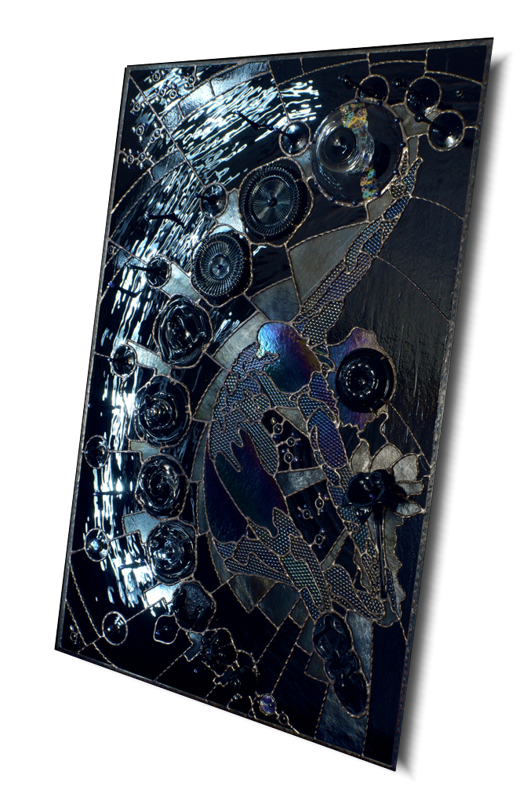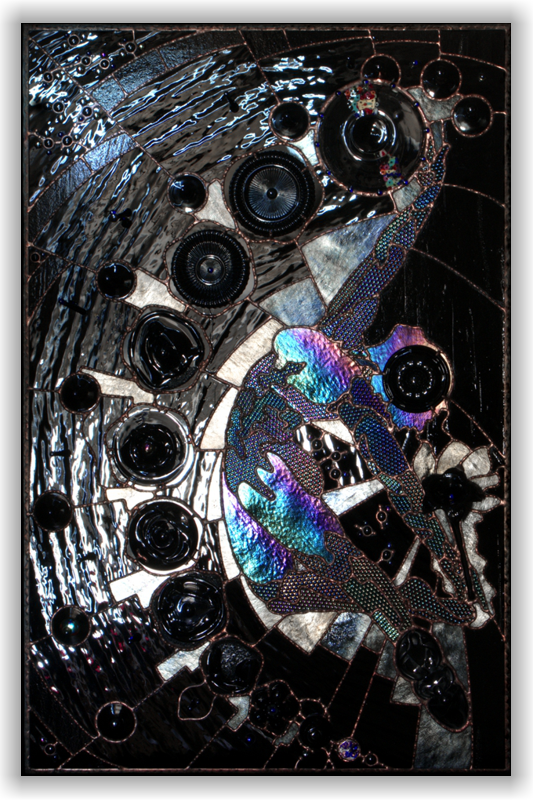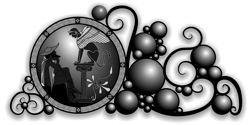| +1-514-400-5214 catalindomniteanu@outlook.com Montreal, QC, Canada | Home | About | Articles | Classes |
Laplace's Demon
88 cm W x 135 cm H x 15 cm D / 12 kg (34.5" W x 53" H x 6" D / 26 lbs)



In what universe do we live: causal, random, or arbitrary?
Laplace's Demon examines the conflicting positions of determinism, randomness, and divine intervention. The things around us seem deterministic, at least some of them. A ball rolls on an inclined plane in a predictable way.
It does it anywhere and anytime, given the same conditions. For randomness to enter the world, the relationship between the caused and the not-caused must be explained.
The hero of Laplace’s Demon is an athlete of knowledge. Against the dark background of the subatomic world he/she arches in an acrobatic jump towards the great Roulette, which is at the end of a sequence of materialization of matter(!).
I follow the impulse to share some of my understanding of how the universe works.
As I delve deeper into the limits of scientific knowledge, I realize something extraordinary, namely that the realm of paradoxes and theoretical enigmas offers those engaging feelings that one would look for in art, theater, film, or literature.
These riddles and the road to deciphering them are a whole universe of emotions drifting between bewilderment, hope, confrontation, exasperation, and exaltation. One can even get actively involved in solving them.
It is an extremely specialized and ambitious field. Though the riddles are not waiting for veneration, but for investigation.
Some of them are millennia old, mixed between science, philosophy, and spirituality. Many have already found their formulations, and the adventure of knowledge is fascinating. Here is the source of my enthusiasm.
The story behind my work begins with Pierre-Simon Laplace2 who, analyzing the work of his predecessor, Isaac Newton3, realized that there was a
terrible balance problem in the mechanics of the heavenly bodies of the Solar System.
The equations suggested that the planets might be on the course of leaving their own orbits. The question of their instability was known to the father of the Law of the Universal Gravity4,
which for the solution proposed a periodic divine intervention. Despite this non-mechanistic solution, Newton's laws of uniformly accelerated motion and the law of gravitational attraction imposed a deterministic
interpretation5 of the universe. Laplace understood very well the
implications of determinism. He asserted that having full knowledge of the state of the universe at some point, and all the laws of nature, such "vast intelligence"6 would be able to predict
the state of the universe one sequence later,
a season later, or an eternity later. Because all things flow from the previous state of the universe, which also flows from its previous state ... and so on. The idea described here is that from the beginning of the world until the end of it
chance cannot be insinuated into the mechanisms of the universe. No uncaused cause enters the system.
Laplace himself did not find a better solution to gravity, a more precise approximation was proposed only 100 years later by Albert Einstein. He combined time and space into a new type of material called
"fabric of space-time"7. But even without
the right mathematical tool, Laplace was convinced that determinism is the measure of past and future states of the universe.
The year was 1814. This troubling statement led to an even more disturbing one, namely that free will8 would be an illusion.
With the development of quantum mechanics9, this guilt-free universe would become a little ambiguous. Heisenberg's uncertainty principle10
came to clarify why the state of a particle cannot be known with infinite precision.
Schrödinger's probability wave function also strengthens the unknowable character of the universe - the particles are no longer occupying a single point in space, but the probability of their existence is distributed simultaneously in a
region called "superposition"11. The quantum entanglement12 questions the notion of vicinity13
- an event at one end of the universe can instantly influence the behavior of its partner at the other end of the universe. Even the notion of simultaneity
has been denied.
Rather, all these scientific discoveries suggest a system that cannot provide the anchors needed for rigorously deterministic construction. However, the idea of causality remains valid for most scientists today. And the strongest argument comes from the
flawless predictability offered by the equations of quantum mechanics on which all electronic equipment is based, from the toaster to the GPS system.
An electron cannot lie, but neither can it know prestige or veneration. Down there, on the Plank scale, the subatomic world manifests itself contrary to our intuitions. The universe is not obliged to conform to them, but the beauty of the world
begins with the laws of physics.
Randomness: if it exists, it deserves to be saved.
1 Vacuum:
The concept of "vacuum" has been used in science and philosophy to indicate that environment in which the material objects of the world exist; it indicates the absence of a being, the nothingness, the empty space, the emptiness, the luminous
ether. Each of these names has more or less different properties. The best definition of a vacuum is probably that of a volume (space) from which everything that can be removed has been removed. But the energy of the vacuum is not zero, it
can be positive but it can also be negative, as Paul Dirac proposed. Moreover, the study of vacuum has shown that virtual particles can reach or disappear in / from the real world.
2 Pierre-Simon, marquis de Laplace (1749–1827):
French scholar and polymath, Laplace believed that all the events in the Universe are produced by agents of causality, and that one can determine the state of a system if one knows the prior state of the system and the rules that governs them.
Applying Newtonian's law of gravitation to the entire solar system he observed that its complexity made mathematical solutions impossible to draw. Even though too complicated, yet he thought of it as a deterministic construct. Moreover,
despite the discord between his equations and the orbits of Jupiter and Saturn, Laplace asserted that the planetary motion is stable. His confidence came, perhaps, from the advancement of mathematics and science, and from his unshaken
belief in determinism.
3 Isaac Newton (1642–1726):
Central character in the scientific revolution with scientific contributions in mathematics, optics, mechanics, and gravity.
4 The Law of Universal Gravitation:
The theory was first published in 1687 by Isaac Newton and states that objects with mass attract each other with a force determined by a relation between their masses, the distance between them, and a universal constant.
5 Determinism:
The idea of a causal flow of events in the universe is reinforced by the mechanical laws of Isaac Newton published in the Philosophiæ Naturalis Principia Mathematica in 1687. Besides the law of universal attraction, Newton proposed a set of
equations describing the principles of motion with constant velocity and with constant acceleration. Therefore, by knowing the initial state of a system, one could make predictions about its state at a later time.
6 Vast intelligence:
The term was used by Pierre-Simon Laplace to describe the concept of a super-intelligent entity that, knowing the state of all particles in the Universe and all the laws that govern it, can calculate both the future and the past. This entity
was later known as "Laplace's Demon".
7 The fabric of space-time:
Einstein's theory of general relativity describes gravity as a dynamic influence exerted by two massive objects on each other in what he called the "space-time fabric," and in which the motion of objects follows the deviations created in this
material by their own masses; the trajectories of the two objects is the effect of continuous deformation of this 'space-time fabric'. Time becomes a function of the magnitude of gravity and speed of movement, so it should be viewed as a player
and not a fixed background.
8 Free will:
Free will is "the canonical identifier for a significant type of control over one's actions" (from the Stanford Encyclopedia of Philosophy). The term "significant" admits a minimum of determinism in the control we have over our actions,
implying at least that determinism cannot be ruled out. According to some, control is actually null, despite our impression of volition over our decisions.
9 Quantum mechanics:
MC is a discipline that explores the behaviour and the properties of the subatomic elements; the term "quantum" indicates that the energy of these elements comes in discrete quantities. MC is one of the most successful theories that has
allowed an impressive technological advance. In an effort to unify gravity with the other fundamental forces, a remarkable approach is to try to quantify gravity itself - "Quantum Loop Gravity". However, unification is not yet solved, and it
is not inconceivable that a new way of thinking would be needed to solve these problems. According to current knowledge, gravity and the fundamental atomic forces do not involve contradictory interpretations, but totally different natures
that do not have a common ground to allow us to formulate the transformation equation.
10 Uncertainty principle:
Put forward in 1927 by Werner Heisenberg, the principle limits the precision with which it can be known the product between the position of a particle and its momentum; the more accurate the information about one of the two parameters, the
greater the error of the other parameter. The very act of observation influences the behavior of the object, ultimately a photon must be released / reflected by it to provide information. The observatory thus becomes part of the environment.
11 Superposition:
Superposition is a property of Schrödinger's equation that combines the notion of 'wave' with that of 'probability'. In quantum mechanics, the Copenhagen interpretation says that a particle does not occupy a single point in space, but a
region of space and not a single point at the same time, but all at once. Its scattered but indivisible energy collapses at a point when an interaction occurs. The very act of observation influences the behavior of the observed object. In
the past, the act of observation made by a conscious being was considered an interaction. A linguistic inaccuracy from which the interpretation that the Universe exists for the conscious being to observe it was born.
Further notes: a) As an alternative to the Copenhagen interpretation, the Everettian multi-verse proposition comes from the interpretation that whenever two options are available, the Universe is divided into two parallel Verses; where
the two possibilities become manifest. b) Given the undulatory feature of everything that exists, the superposition seems justifiable - a wave needs something of a "bodily" nature, rather than a "punctiform" nature. The Greek atomists must have
established an illusory basis when they claimed that the smallest constituent of the universe has the features of a particle.
12 Quantum entanglement:
This is the property of two paired particles to remain in a special correspondence at any distance. Einstein rejected this interpretation, which he called "spooky action at a distance" and offered the solution of hidden variables. In 1953,
though, John Bell proposed a way to test this, and the results seem to have invalidated Einstein's suggestion. Quantum entanglement is a property that defies all the principles of physics in that information and energy are no longer
transmitted locally but at a distance, and not at sub-luminous speed but instantaneously. An interesting approach proposed in 2019 by Sean Carroll argues that the term "local" should be defined in relation to possible interactions, not by
distance. Thus, two objects will be considered in close proximity to each other by way of the interactions between them. The space becomes irrelevant.
13 Principle of locality:
This paradigm of the macro-world experience suggests that in order for an object to influence another object it must be close to it, to touch it. In fact, the subatomic world reveals that there is no real "touch" between objects, but that
forces of attraction or repulsion between bodies begin to manifest themselves at certain distances. These distances define the principle of "locality". The objects must therefore be side by side in order to influence each other ... with
the exception of quantum entangled particles.
Final note:
The above foundational concepts in QM&G successfully predict how they operate. Yet they are not presented with a describing mechanism. The situation is similar to one knowing that the car goes right when turning the steering-wheel right,
whithout knowing what gears, pivots, or pulleys are cinematically engaged under the hood. The situation lingers in science since the introduction of probability in the equations describing matter, in the first quarter of the XXth century, and
it perplexes many scientitsts. "Those who are not shocked when they first come across quantum theory cannot possibly have understood it.", said Niels Bohr in 1952.
"Nobody understands quantum mechanics", said Richard Feynman in 2010. As for me, I find this such an exceptional matter, that I think it's art.

Copyright © 2021 Catalin Domniteanu. All rights Reserved.